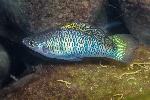Swordtail Fry Attend to Chemical and Visual Cues in Detecting Predators and Conspecifics
Por Coleman, Seth W., Gil G. Rosenthal
Plos One, 1-4 2006
" Predation pressure and energy requirements present particularly salient opposingselective pressures on young fish. Thus, fry are expected to possess sophisticated means of detecting predators and resources. Here we tested the hypotheses that fry of the swordtail fish Xiphophorus birchmanni use chemical and visual cues in detection of predators and conspecifics. To test these hypotheses we presented young (<7 day-old) fry with combinations of visual and chemical stimuli from adult conspecifics and predators. We found that exposure to predator odors resulted in shoal tightening similar to that observed when fry were presented with visual cues alone. In trials with conspecific stimuli, fry were particularly attracted to adult conspecifics when presented simultaneous visual and chemical stimuli compared to the visual stimulus alone. These results show that fry attend to the odors of adult conspecifics, whose presence in a particular area may signal the location of resources as well as an absence of predators. This is one of the first studies to show that such young fish use chemical and visual cues in predator detection and in interactions with conspecifics. Previous research in X. birchmanni has shown that anthropogenic alteration of the chemical environment disrupts intraspecific chemical communication among adults; we suggest that because fry use the same chemosensory pathways to detect predators and conspecifics, alteration of the chemical environment may critically disrupt predator and resource detection "
Idioma: English
Referencia en bibliografía de especies (1)
Coleman, Seth W. & Gil G. Rosenthal. 2006. "Swordtail Fry Attend to Chemical and Visual Cues in Detecting Predators and Conspecifics". Plos One. 1-4 (ffm00323) (resumen)
